Feeling cramped in your backyard?
Let me share my little garden journey. I used to think small spaces couldn’t sparkle—oh, how wrong I was!
Tiered beds? Game-changer! Who knew I could fit a jungle into a shoebox?
Those VegTrug modular raised beds? Absolute lifesavers. Swapping seasonal crops has become my new hobby (and confuses the squirrels to no end).
And don’t get me started on square foot gardening—a magic trick for high yields in my tiny patch.
I’m all for using recycled materials, like wooden pallets. They’re budget-friendly and add some rustic charm—perfect for when I’m trying to impress my friends with my “green thumb.”
But really, is there such a thing as “too many plants”?
As I dive deeper, I realize that designing a garden is a wild emotional ride of trial and error. Who knew dirt could be so complex?
So, are you ready to unlock the full potential of your tiny garden?
Finding Inspiration in Urban Balconies
I remember the first time I transformed my tiny balcony into a mini garden oasis. It was a simple act of placing a few herb pots, but the connection was profound.
Suddenly, I had fresh basil at my fingertips and a beautiful view to enjoy. Every morning, the aroma wafted through my kitchen, making me feel like a culinary pro.
I even got a bit bold—adding vertical planters! This green adventure taught me about companion planting and the importance of maximizing light.
It’s a journey of creativity, using every inch wisely.
So, whether you’re out to grow herbs or create a breathtaking flower display, every step in garden design comes with its little surprises. What will you discover?
Quick Takeaways
- Utilize vertical gardening techniques, such as trellises and pocket gardens, to maximize limited space and enhance plant diversity.
- Build modular raised beds that adapt to seasonal crops and fit snugly in compact areas while ensuring optimal sun exposure.
- Implement L-shaped garden beds in corners to effectively utilize space and add visual interest with integrated trellises for climbing plants.
- Adopt square foot gardening and companion planting methods to increase productivity and resource efficiency in smaller garden spaces.
- Use budget-friendly materials, like repurposed pallets and wine barrels, to create functional, aesthetically pleasing raised beds that also support sustainability.
Maximizing Vertical Space With Tiered Beds
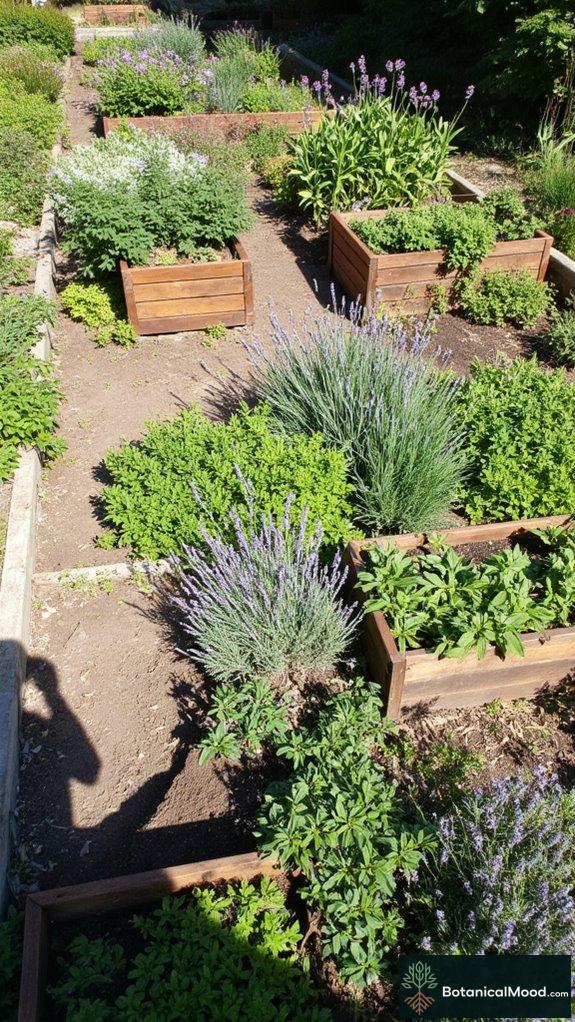
When you’re working with limited space, implementing tiered garden beds can transform your compact area into a vibrant, lush oasis.
These innovative structures not only maximize vertical space but also create stunning visual interest in your garden. By layering beds, you can cultivate a diverse array of plants, from fragrant herbs to striking flowers, all while enhancing sunlight exposure and drainage.
I personally love using cedar for its durability and aesthetic charm. Consider integrating color choices that pop, like deep purples against rich green foliage.
Every corner of your space can reveal beauty, contributing to an inviting, harmonious atmosphere that I deeply appreciate. Additionally, using modular expansion ideas allows for flexibility in your garden design, enabling you to adapt and grow as your gardening needs change.
Modular Raised Beds for Flexible Gardens

Modular raised beds present an innovative solution for gardeners like me who want flexibility in compact spaces.
These adaptable structures allow me to configure my garden layout according to seasonal crops, sun exposure, or personal whims. With options from brands like VegTrug or GrowBox, I can mix different sizes and shapes, creating unique designs that suit my aesthetic and practical needs.
With modular raised beds, I can effortlessly adapt my garden layout to seasonal changes and personal preferences.
I appreciate the ability to change planting zones without permanent commitment, aligning with my botanical interests. Additionally, these systems can host sustainable DIY interlocking planter designs, making them even more versatile.
The rich colors and textures of the plants pop against the structured frames, bringing life to even the smallest urban gardens.
Square Foot Gardening: High-Yield Layouts

In the pursuit of maximizing garden productivity, square foot gardening offers an efficient layout that transforms even the tiniest of spaces into vibrant, bountiful plots.
By segmenting a garden into square-foot sections, I can cultivate a diverse array of vegetables, herbs, and flowers side by side, ensuring ideal use of soil, sunlight, and nutrients.
With innovative techniques like grid systems, trellises, and companion planting, I’ve achieved impressive yields in small areas.
This method’s adaptability encourages creativity, allowing me to experiment with colors and textures, enriching both the aesthetic and functional aspects of my compact garden.
It also inspires others to embrace this unique gardening philosophy passionately.
Repurposed Materials for Budget-Friendly Beds

Exploring the potential of repurposed materials can elevate a compact garden bed into a clever and aesthetically pleasing solution.
For instance, old wooden pallets can be transformed into raised beds, offering a rustic charm. Metal troughs provide industrial flair, while old bricks create lasting borders. You might even consider using wine barrels for a unique, rounded effect, and they fit snugly in any corner.
I love sourcing these materials locally, often from yard sales or community swaps. Each piece adds character, allowing you to cultivate a beautiful garden on a budget.
Embracing innovation in repurposing not only saves money, it cultivates sustainability.
Incorporating Edible Landscaping Into Design

Creating a harmonious blend of aesthetics and functionality often comes from the thoughtful incorporation of edible landscaping into garden designs, especially in compact spaces.
I find that investing in vertical gardening systems, like Planter Boxes or Wall-mounted Herb Gardens, maximizes space while offering visual appeal.
Integrating vibrant edible plants such as Swiss chard, strawberries, or culinary herbs not only beautifies the garden but also enriches our lives with fresh produce.
Additionally, using strategically placed pots allows for delightful splashes of color and texture, transforming narrow pathways into sensory experiences.
This seamless combination of beauty and utility truly enhances our outdoor spaces.
Raised Planters as Garden Dividers
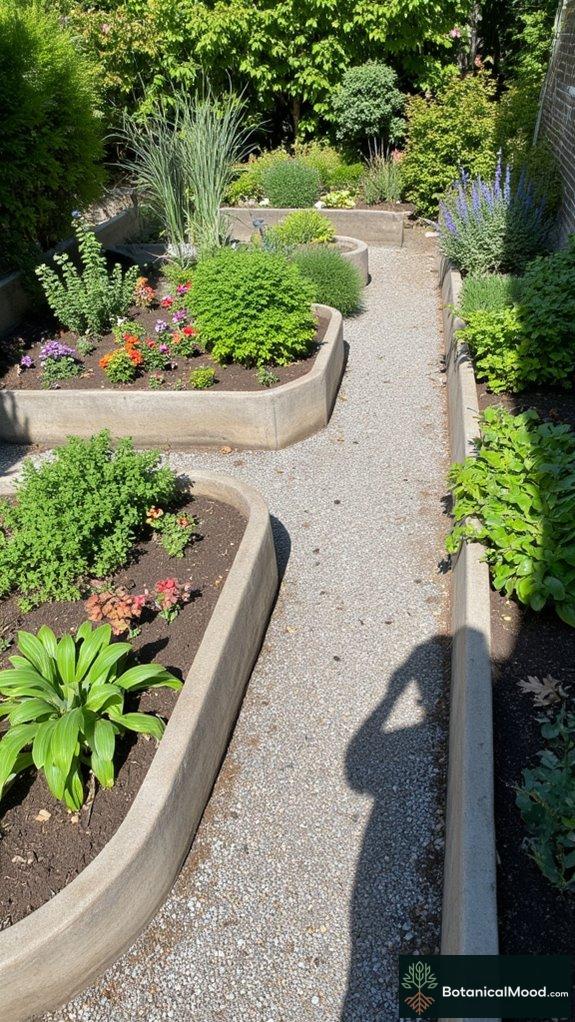
Raised planters can ingeniously define and segment compact garden spaces, providing both structure and style.
I’ve found them to be transformative for dividing areas while adding height and visual interest.
Here are some innovative ideas I love:
- Create a winding path with curved planters to guide the eye.
- Use tiered raised planters to maximize vertical space and display a variety of plants.
- Combine color-coordinated blocks to establish a cohesive design theme.
- Incorporate edible and ornamental plants to enhance both beauty and functionality.
With these raised planters, your garden becomes a canvas, and you’ll feel the creative energy flowing.
Utilizing Microclimates for Diverse Planting

Microclimates play a crucial role in shaping the beauty and diversity of compact gardens, particularly when each nook and cranny can offer a distinct growing environment.
I’ve discovered that placing heat-loving plants, like tomatoes and peppers, against south-facing walls creates a cozy pocket for growth, while ferns and shade-lovers thrive in cooler corners.
Strategically utilizing tall elements, such as trellises or vertical gardens, fosters airflow and balances sun exposure.
L-Shaped Beds for Corner Utilization
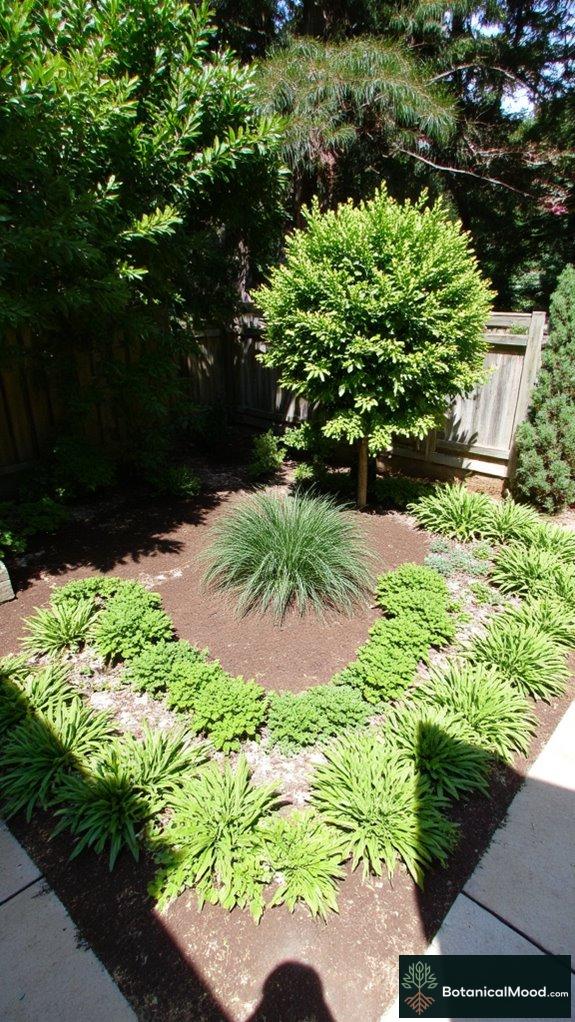
When space is limited, utilizing L-shaped garden beds can transform corner areas into practical and beautiful planting zones.
These innovative designs add dimension while maximizing space efficiently. Here’s why I adore them:
- Maximized Planting Area: L-shapes allow for deeper soil without compromising space.
- Improved Accessibility: Easy access for maintenance and harvesting, enhancing usability.
- Better Microclimates: Corners often create ideal environments for plants that thrive in sunlight.
- Aesthetic Appeal: The unique angles add visual interest to your garden design.
L-shaped beds can redefine corners, making them vibrant focal points that enhance your outdoor oasis beautifully.
Adding Seating: Combining Function With Style
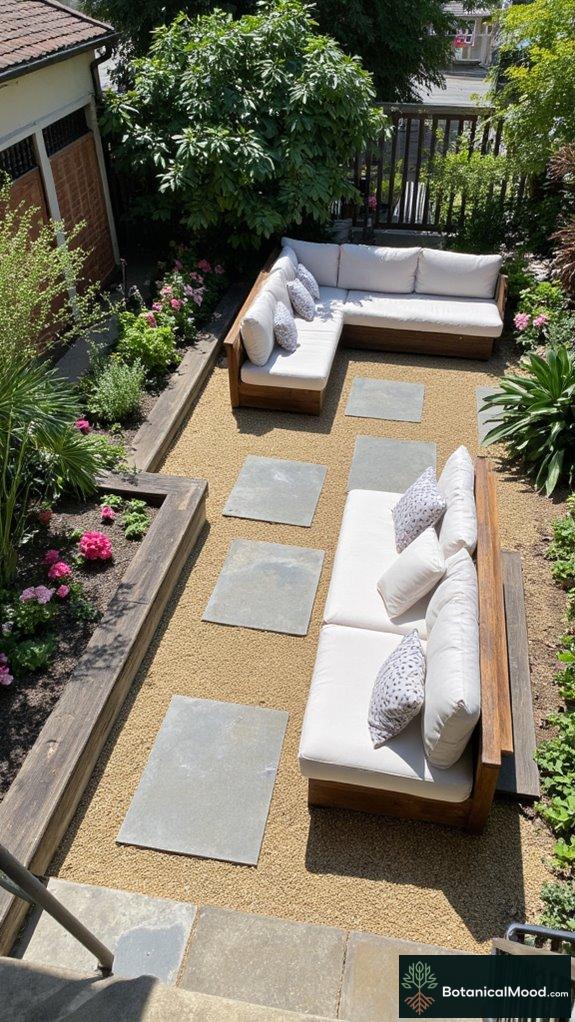
Incorporating seating into compact garden designs can truly elevate the overall experience of your outdoor space, transforming it into a welcoming retreat.
I’ve discovered that sleek, modular seating options, like those from brands such as West Elm or CB2, blend modern aesthetics with practicality. Consider stylish benches that double as storage, or vibrant hammocks that punctuate your garden with color and comfort.
Positioning these elements near floral beds or raised planters not only fosters intimacy but also invites relaxation amid nature’s beauty.
Compact Container Gardens on Raised Frames

Have you ever considered the charm and practicality of compact container gardens on raised frames?
These innovative designs not only maximize small spaces but also allow for creative plant arrangements.
Here are four benefits that draw me to these elevated gardens:
- Improved Drainage: Elevated frames prevent waterlogging, fostering healthy root systems.
- Enhanced Mobility: Adjustable heights make maintenance easy, reducing strain on your back.
- Aesthetic Appeal: Beautifully crafted frames add structure and style to any garden.
- Versatile Planting: Mix herbs and flowers for a vibrant, functional space.
I truly appreciate how these elements unite beauty and efficiency in gardening.
Elevated Beds for Easier Access

Elevated garden beds create a harmonious bridge between convenience and aesthetics, allowing gardeners to engage with their plants without the strain of bending or kneeling.
I love how these beds, often crafted from rot-resistant materials like cedar or composite wood, not only enhance accessibility but also lend a modern touch to any compact space.
Utilizing vertical space efficiently, I can grow a variety of herbs, vegetables, and flowers, transforming my garden into a vibrant palette.
Brands like Gardener’s Supply Company offer innovative designs that incorporate self-watering systems, making maintenance a breeze.
Elevate your garden experience—it’s a game-changer for any compact area!
Multi-Use Designs: Garden and Play Areas

When space is limited, designing a garden that seamlessly blends functionality with play areas can transform your compact yard into a whimsical retreat.
Here are some multi-use design ideas:
- Vertical Planters: Utilize walls or fences to support climbing plants while saving ground space for play.
- Edible Terrain: Integrate fruit-bearing shrubs alongside swings for a flavorful and fun experience.
- Modular Seating: Use benches that double as storage for outdoor toys, providing utility without sacrificing style.
- Sandbox Integration: Frame a sandbox within a raised bed, allowing kids to dig and explore within a colorful garden.
These concepts inspire innovation, aligning beauty with practicality in delightful harmony.
Pathway Planning for Accessibility
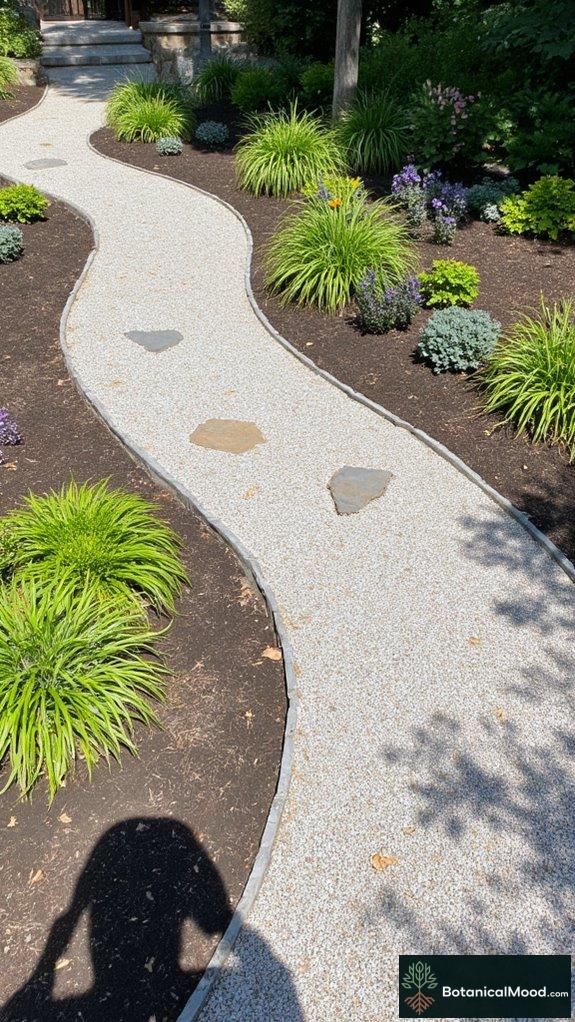
Creating a pathway that allows everyone to access and enjoy your garden is essential, especially in compact spaces where every inch counts.
I’ve found that utilizing permeable materials like gravel or stepping stones not only creates visually appealing designs but also offers functionality.
Consider the width; at least 36 inches guarantees accessibility for wheelchairs and strollers.
Integrating raised beds along the pathway can enhance the usability, allowing you to appreciate heights without compromising space.
Add plantings with varying textures and colors for a rich experience.
Through careful planning, including accessible paths promotes inclusivity and transforms your garden into a delightful haven for all.
Vertical Gardening With Wall-Mounted Beds

While compact spaces can pose challenges in garden design, wall-mounted beds offer a creative solution that maximizes vertical space and adds a stunning aesthetic to any garden.
I love how these innovative beds not only save square footage but also showcase beautiful blooms and fresh herbs.
Consider these key advantages:
- Space Efficiency: Utilize walls for planting, freeing up ground space.
- Accessibility: Easy access to crops reduces bending and back strain.
- Design Versatility: Customize styles with materials like reclaimed wood or metal.
- Increased Yield: Grow diverse plants in a concentrated area, improving harvest potential.
Embrace this approach!
Square and Rectangle Combinations for Efficiency
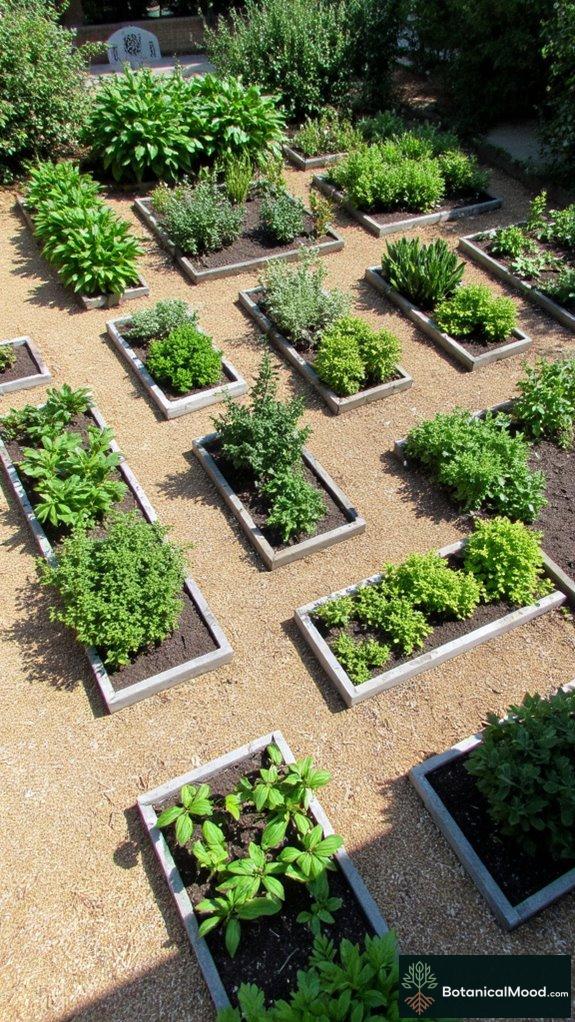
Square and rectangle combinations in garden bed design can greatly enhance the efficiency of compact spaces.
They allow for maximized planting areas while maintaining accessibility, which is essential in urban gardening.
I’ve experimented with these geometric layouts using modular raised beds from brands like Gardener’s Supply Company, enabling easy crop rotation and diverse planting strategies.
Hidden Storage in Raised Garden Benches
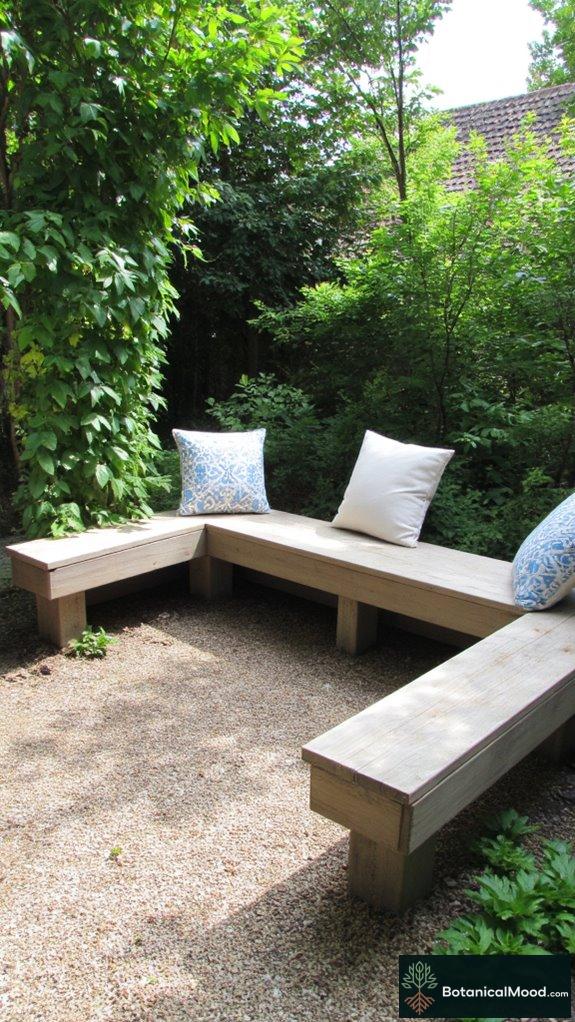
Combining functionality and aesthetics is where raised garden benches truly shine, especially in compact spaces.
Raised garden benches seamlessly blend functionality and beauty, making them perfect for maximizing compact spaces.
I’ve discovered that these benches don’t just serve as seating; they cleverly incorporate hidden storage, maximizing every inch of space.
Here are four innovative ideas for hidden storage:
- Under-seat compartments: Safely stash gardening tools or gloves.
- Lift-up tabletops: Create a concealed workspace for planting.
- Built-in shelving: Organize pots and soil within the bench.
- Cushioned tops with storage: Dual-purpose seating that hides supplies effortlessly.
In my experience, these designs enhance both utility and beauty, transforming any garden into a serene retreat.
Seasonal Rotations: Adaptive Bed Designs
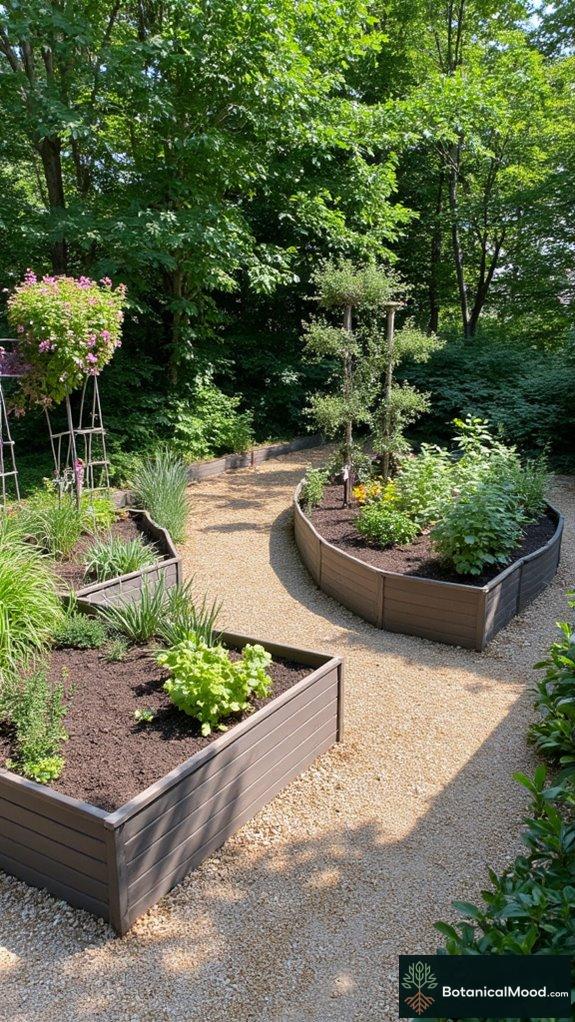
When planning a garden bed design, it’s essential to contemplate the dynamic nature of seasonal rotations, as they dramatically influence the health and productivity of your plants.
My experience has shown that integrating adaptive designs, like modular raised beds or vertical planting systems, allows for easy rearrangement based on seasonal needs.
Innovative Raised Bed Layouts
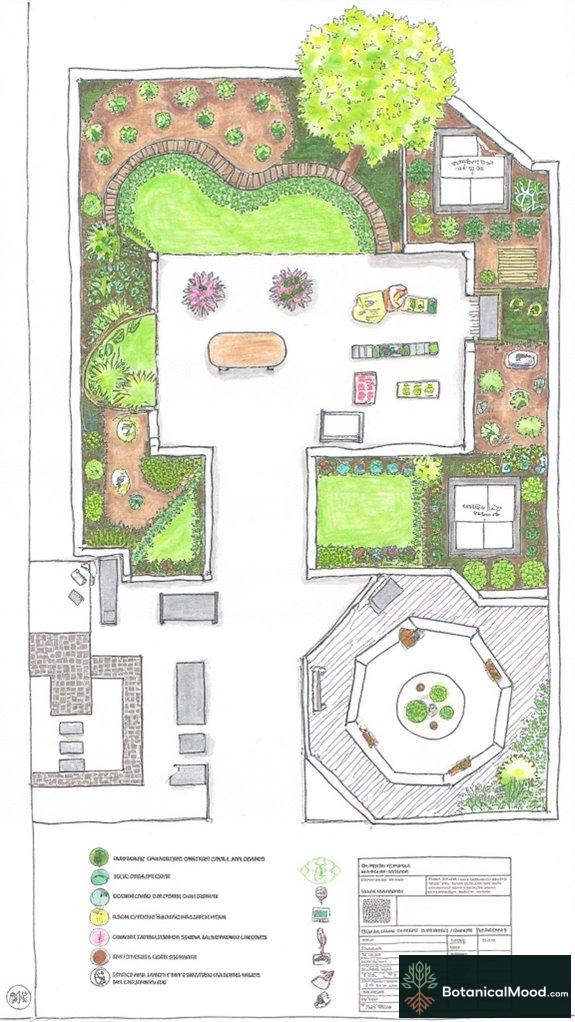
Innovative raised bed layouts have the power to transform even the smallest gardening spaces into lush, productive environments.
Here are some clever designs to take into account:
- Multi-functional beds with built-in seating or storage, maximizing space utility.
- Octagon-shaped beds featuring keyhole designs enhance accessibility without soil disruption.
- Modular configurations allow for advancing planting strategies, encouraging biodiversity through companion planting. Utilizing space efficiently can significantly boost the amount of crops you produce without compromising on quality.
- Container-based options provide portability, permitting swift repositioning for ideal light conditions.
Vertical Gardening Techniques Explored

Have you ever considered how vertical gardening can revolutionize your compact space into a vibrant oasis?
By incorporating trellises for vining crops like cucumbers and beans, I’ve maximized my vertical growth area.
Fabric pocket gardens crafted from old jeans or canvas work wonders for herbs, while repurposed pallets add rustic charm and functionality.
My vertical towers of leafy greens thrive, benefiting from improved airflow and drainage.
Using hanging baskets, I’ve created layered displays that not only look gorgeous but also enhance yield efficiency.
These ingenious techniques, often highlighted on my website, Botanical Mood, transform small spaces into lush, green retreats.
Optimized Bed Configurations for Yards

The art of effectively utilizing space isn’t just limited to vertical gardening; optimized bed configurations play an essential part in maximizing every inch of your yard, particularly when dealing with limited dimensions.
- In spaces 6 by 12 feet or larger, try two raised beds, accessible from all sides.
- For medium yards of 10 by 12 feet, place beds side-by-side with 2-3 feet pathways for easy access.
- Utilize north-south bed orientations for consistent sunlight.
- Modular raised bed kits allow adaptable designs to fit unique spaces, offering a beautiful solution to compact gardening challenges.
Space-Saving Bed Design Tips
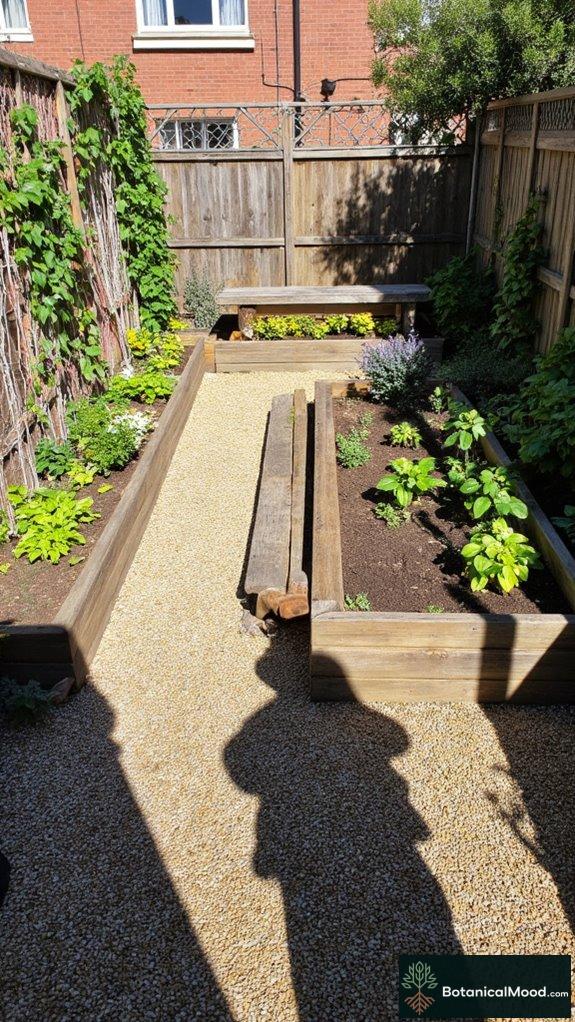
When aiming to create a thriving garden in confined spaces, understanding space-saving bed design is essential, as it allows us to maximize our planting area while maintaining accessibility and aesthetic appeal.
Incorporating vertical gardening elements, like trellises for climbing plants, instantly boosts yield without crowding.
Using narrow, L-shaped beds along fences can transform overlooked corners into productive zones. Multi-functional designs, combining seating or storage with planting beds, enhance utility without sacrificing beauty.
This thoughtful arrangement captures the essence of a well-structured garden, harmonizing nature’s bounty with innovative space management—a principle I cherish at Botanical Mood, where creativity meets practicality.
Decoration With Raised Bed Garden Layout Inspirations
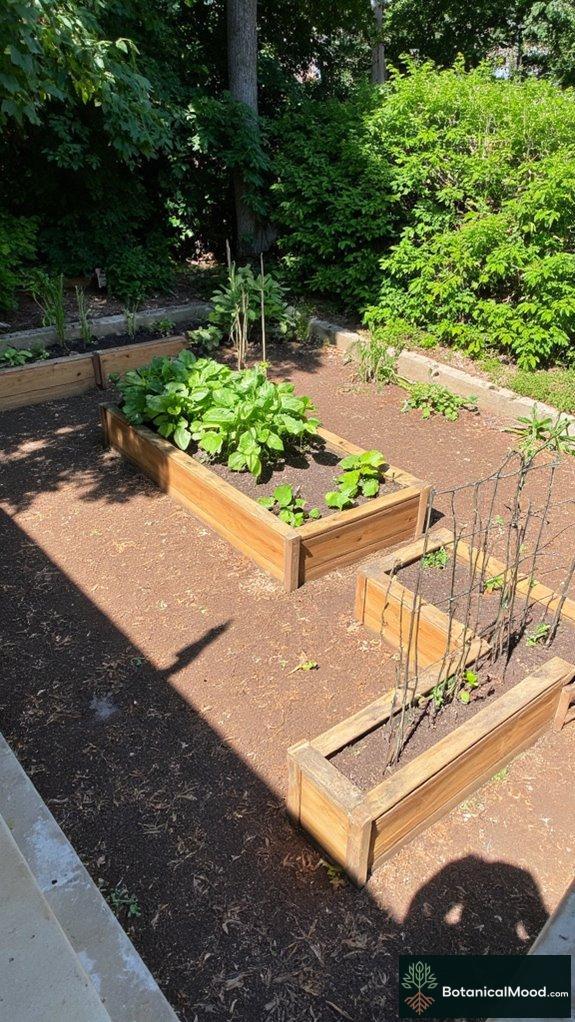
Creating a visually engaging raised bed garden layout enhances not just the functionality but also the aesthetic appeal of compact spaces.
Consider these inspiring ideas to elevate your garden:
- Four-Garden Classic – Divide your space into four equal raised beds for crop separation and symmetry.
- L-Shaped Beds – Maximize corners with L-shaped designs that wrap around features.
- Incorporate Trellises – Use obelisks or arch trellises to add vertical interest and define entrances.
- Outdoor Room Concept – Arrange beds as walls to create an immersive gardening experience.
These innovative layouts not only beautify but also enhance your gardening efficiency.
Meet the Garden’s Creator
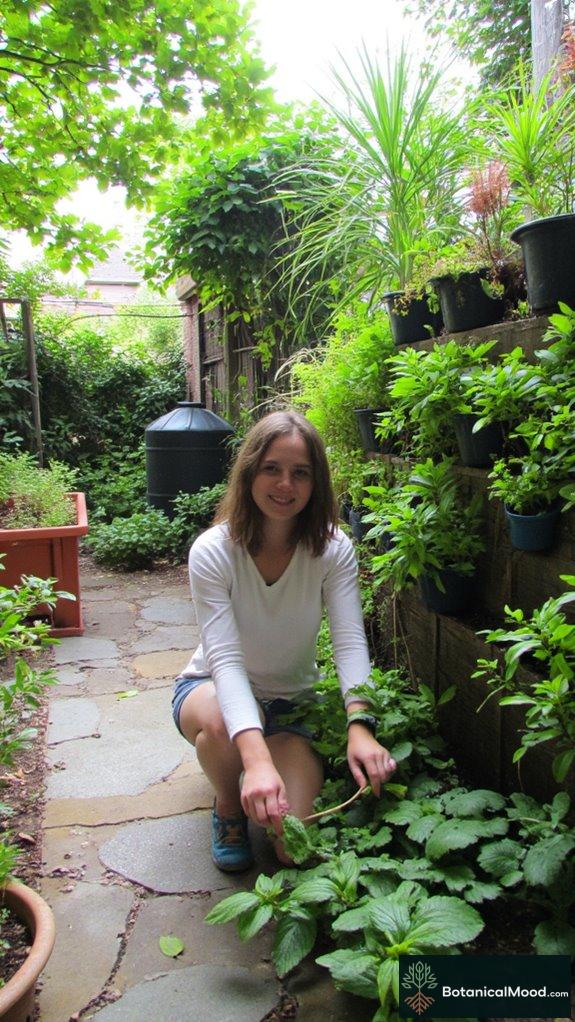
Meet Emily Johnson from Portland, Oregon, whose journey toward creating a vibrant garden stemmed from her love for botany and a desire to transform her compact urban yard into a tranquil oasis.
To bring her vision to life, Johnson collaborated closely with a local garden designer, focusing on sustainable practices and maximizing space utilization. Through a phased approach, she carefully planned each element, integrating personal touches that reflect her lifestyle and aesthetic preferences.
Johnson utilized custom planters from manufacturers like Vego Garden, along with vertical gardening systems from GreenStalk, to enhance her design.
She incorporated natural materials such as bluestone and implemented efficient irrigation techniques with rain barrels, exemplifying the harmonious blend of functionality and artistry inspired by expert horticulturists.
Renowned Gardening Experts and Brands

As I explore the vibrant world of gardening, I’ve discovered that renowned gardening experts and brands play an essential role in shaping our understanding of small space designs.
Brands like Proven Winners inspire with bold color palettes, combining striking petunias with vibrant foliage, creating visual intrigue in compact beds.
Proven Winners captivates with bold color combinations, blending vibrant petunias and foliage to enhance compact garden designs.
Modular kits from Vego Garden offer flexible configurations, perfect for unique spaces, while Gardenary’s DIY plans guide us to construct beautiful raised beds with practicality.
Additionally, innovative designs from Savvy Gardening, such as corrugated steel rolling beds, merge artistry with function, addressing the increasing demand for enchanting, yet functional gardening solutions in limited areas.
Garden Design FAQ
What Are the Best Crops for Raised Beds in Small Spaces?
For raised beds in small spaces, I find compact crops like radishes, lettuce, and bush beans to be the best options. They mature quickly and maximize yield in limited areas.
Herbs, especially basil and parsley, thrive with vertical planting techniques. I enjoy incorporating strawberries for both beauty and taste.
With thoughtful planning and seasonal rotation, I create vibrant, productive gardens that offer both aesthetic joy and rewarding harvests, nurturing my passion as a gardener.
How Can I Maintain Soil Health in Compact Raised Beds?
Maintaining soil health in compact raised beds is like nurturing a delicate balance in a mini ecosystem. I regularly amend the soil with organic materials such as compost and aged manure, ensuring it remains nutrient-rich.
Crop rotation and companion planting keep pests at bay while enhancing biodiversity. I monitor moisture levels closely, utilizing drip irrigation to prevent over-saturation.
What Are Tips for Watering Raised Beds Efficiently?
To water raised beds efficiently, I recommend using a drip irrigation system. It delivers water directly to the root zone, minimizing evaporation.
I position soaker hoses along the soil’s surface for even moisture distribution, ensuring every plant thrives. Mornings work best for watering to reduce fungal risks.
I also incorporate moisture-retaining mulch around my plants, which helps conserve water and reduce the frequency of watering.
With these methods, I keep my garden vibrant and healthy.
How Do I Protect Raised Beds From Pests?
To protect my raised beds from those pesky garden intruders, I integrate several strategies that enhance both aesthetics and functionality.
I use fine mesh netting to shield my crops while still allowing sunlight through. I also plant companion plants, like marigolds, which naturally deter unwanted visitors.
Furthermore, I maintain a clean garden, making certain debris doesn’t become a hiding spot for pests.
These clever practices guarantee my garden remains a thriving haven.
Can I Integrate Flowers in My Vegetable Raised Beds?
Absolutely, I’ve successfully integrated flowers into my vegetable raised beds. Companion planting, like pairing marigolds with tomatoes, not only attracts beneficial insects but also enhances pest resistance.
I often choose vibrant nasturtiums alongside greens; their colors pop and their flavors add a gourmet touch.
When selecting flowers, make sure they’re non-invasive and compatible with your veggies, ensuring both beauty and productivity. My raised beds thrive, blending aesthetics with functionality beautifully.
References
- https://growinginthegarden.com/raised-bed-garden-design-backyard-layout-ideas-that-work/
- https://www.finegardening.com/article/build-your-own-raised-beds
- https://humboldtssecretsupplies.com/blogs/articles/the-7-most-practical-raised-garden-bed-plans
- https://joegardener.com/podcast/raised-bed-gardening-pt-1/
- https://miraclegro.com/en-us/projects-planning/raised-bed-garden-ideas.html
- https://ecogardener.com/blogs/news/raised-beds-for-small-yards-to-save-space
- https://food52.com/story/26018-how-to-build-a-raised-garden-bed
- https://savanagarden.com/blogs/raised-beds-gardening-blog/innovative-garden-bed-ideas-for-small-urban-spaces
- https://www.gardenary.com/blog/our-favorite-diy-raised-garden-bed-ideas
- https://extension.umn.edu/news/vertical-gardening-maximizing-space-minnesota-gardens

Leave a Reply